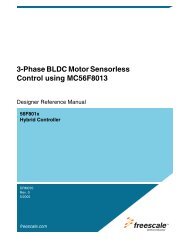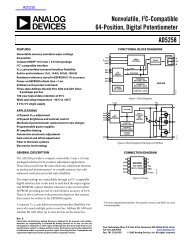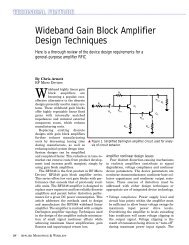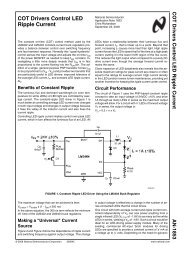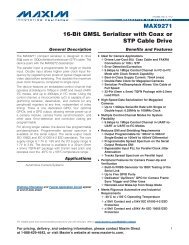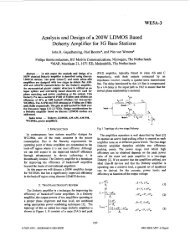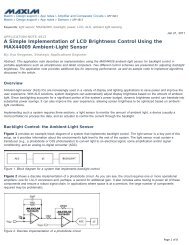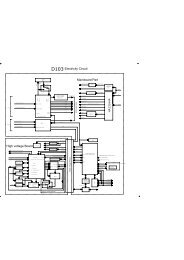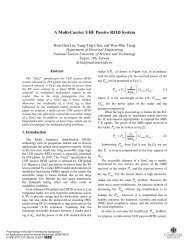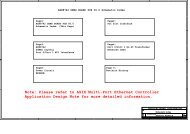Ansoft Designer
Ansoft Designer
Ansoft Designer
You also want an ePaper? Increase the reach of your titles
YUMPU automatically turns print PDFs into web optimized ePapers that Google loves.
Passive Microwave Component<br />
Design and Optimization<br />
Haiqiang Ding<br />
Senior Application Engineer<br />
<strong>Ansoft</strong> Beijing Office<br />
Jolly Zhou<br />
Senior Application Engineer<br />
<strong>Ansoft</strong> Shanghai Office
Abstract<br />
• Challenges of Modern Microwave Component and<br />
Antenna Design<br />
• Waveguide Slot Array Computer Aided Design and<br />
Simulation<br />
• Rapid Direction-Finding Antenna Array Design<br />
• Satellite Communication Antennas Simulation<br />
• Rotary Joint Optimization
Modern Microwave Component and<br />
Antenna Design<br />
• Higher Performance<br />
• More Complex<br />
• Complex Radiation Pattern<br />
• System Level Design<br />
• Design Cost and cycle
Benefits of using Electromagnetic Field<br />
Solvers<br />
• Make Good Thinking to Good Design<br />
• Decrease Instruments Time<br />
• Design Costs and Cycle<br />
• Human Resource
Requirements of Electromagnetic Field<br />
Simulators for Modern Design<br />
• Accuracy,Reliable and Fast<br />
• Simulation Capacity<br />
• Real Arbitrary 3D Structure<br />
• Easy to Use<br />
• Technical Support
<strong>Ansoft</strong> HFSS: Golden Tool for Antenna and<br />
Passive Microwave component Design<br />
• Powerful Features<br />
• Accuracy,Reliable and Fast<br />
• More than 10,000 customer all over the word<br />
• Adaptive Meshing<br />
• Technical support
Waveguide Slot Array Computer<br />
Aided Design and Simulation
Waveguide Slot Array Antenna<br />
Waveguide Slot Array Antennas are well used<br />
in Defense such as Radar on Fighter, Missile or<br />
ground.<br />
•Good Antenna Gain, low side lobe and VSWR<br />
•Good Mechanical performance<br />
Ground Radar<br />
Radar on Aircraft
Waveguide Slot Array<br />
Waveguide Slots<br />
• Slots in Waveguide Slot Array antennas<br />
• Every slot is different: depend on the array factor<br />
• Prototype for the slots is tiresome<br />
• Use HFSS design every slot and get design curve
Waveguide Slot<br />
• Broadwall Displaced Slot<br />
• Broadwall inclined Slot<br />
• Edge Wall Slot
<strong>Ansoft</strong> HFSS<br />
Broadwall Displaced Slot Design<br />
• Y martix in the test port will equal to the Ymartrix in the center of the<br />
slot when the distance is half of guide wave wavelength<br />
• To get the guided wavelength, just perform a “ports only” solve in<br />
HFSS<br />
• When the slot is resonant, Im(Y(11)) =0<br />
¼Lg<br />
½ Lg<br />
Lg: Guided wave<br />
wavelength<br />
Offset<br />
Test Port<br />
Short<br />
length
<strong>Ansoft</strong> HFSS<br />
Broad wall Displaced Slot Design<br />
Build the simulation model in<br />
HFSS v9<br />
Direct parametric<br />
Very easy to use<br />
Set variable in /HFSS/design<br />
properties/local variables<br />
Design parameters<br />
• length:resonant length of<br />
slot, to be optimized<br />
• Offset: Slot center displace<br />
from the waveguide center
<strong>Ansoft</strong> HFSS<br />
Broad wall Displaced Slot Design<br />
• When the slot is resonant, Im(Y)=0<br />
• Use ABS(Im(Y)) as cost function<br />
• Change offset from 1mm to 8mm, step<br />
1mm, optimize length (resonant length)<br />
at every point<br />
• Design curve is generated
<strong>Ansoft</strong> HFSS<br />
Broadwall Displace Slot Design<br />
• Optimization variable setting in<br />
HFSS v9<br />
• Length will be optimized
<strong>Ansoft</strong> HFSS<br />
Broad wall Displaced Slot Design<br />
• Optimization in HFSS v9<br />
• Cost function changes when optimization
Broad wall Displaced Slot Design<br />
Generate Slot Design Curve<br />
• Design curve is generated by HFSS v9 and optimization<br />
• Resonant length of wave guide slot vs. Offset distance
<strong>Ansoft</strong> HFSS<br />
Broad wall Inclined Slot Design<br />
• Y martix in the test port will equal to the Ymartrix in the center<br />
of the slot when the distance is half of guide wave wavelength<br />
• Also, when the slot is resonant, Im(Y(11)) =0<br />
¼Lg<br />
½ Lg<br />
Lg: Guided wave<br />
wavelength<br />
Rang<br />
Test Port<br />
Short<br />
length
<strong>Ansoft</strong> HFSS<br />
Broad wall Inclined Slot Design<br />
• Inclined angle<br />
changes from 10<br />
degree to 35 degree,<br />
5 degree step<br />
• Optimize resonant<br />
length at every<br />
inclined angle
Broad wall Inclined Slot Design<br />
Generate Slot Design Curve<br />
• Resonant length of wave guide slot vs. Inclined Angle
<strong>Ansoft</strong> HFSS<br />
Waveguide Slot Array Antenna Simulation<br />
• The whole simulation<br />
model in HFSS v9,<br />
Frequency is 3cm band<br />
• All coupling between the<br />
slots are taken into account<br />
• More than 200 radiation<br />
slots and 40 coupling slots<br />
• Very large in electric size<br />
• Symmetry can be used to<br />
reduce computation time
<strong>Ansoft</strong> HFSS<br />
Waveguide Slot Array Antenna Simulation<br />
• 3D radiation pattern<br />
when two ports are in<br />
same phase<br />
• Simulation time(PC):<br />
• 2:30 CPU time<br />
• 212,305 Tetrahedral
<strong>Ansoft</strong> HFSS<br />
Waveguide Slot Array Antenna Simulation<br />
• 3D radiation pattern when<br />
two ports are 180 degree<br />
different in phase<br />
• Zero lobe in Z axies<br />
• Being a frequency domain<br />
solve, HFSS can get this<br />
without re-solve the project:<br />
just set the phase of the<br />
ports
<strong>Ansoft</strong> HFSS<br />
Waveguide Slot Array Antenna Simulation<br />
• Compare with test result (two ports in<br />
same phase)<br />
• Simulation Result:<br />
• 3dB lobe width: 3.7 degree<br />
• back lobe level: -34dBc<br />
• Test Result:<br />
• 3dB lobe width: 3.67 degree<br />
• back lobe level: -34dBc
Rapid Direction Finding<br />
Antenna Array Design
The Principle of Direction Finding<br />
• In the traditional interferometer<br />
Direction-Finding<br />
r 1<br />
r 0<br />
r 2<br />
4#<br />
1#<br />
<br />
D<br />
2#<br />
3#
The Principle of Direction_Finding<br />
• The electric field of “incident wave” at the various<br />
antennas is as follows:<br />
E<br />
jIl sin θ k<br />
4π<br />
ωε<br />
× k<br />
r<br />
θ i =<br />
exp( − jkr i)<br />
i = (1,2,3,4 )<br />
i<br />
E<br />
θi<br />
=<br />
E ( r 0)<br />
exp( − jkr i)<br />
• The propagating path differences between various<br />
antennas by the “incident wave” <br />
φ<br />
φ<br />
12<br />
34<br />
2πD<br />
= sinϕ<br />
cosϑ<br />
λ<br />
2πD<br />
= cosϕ<br />
cosϑ<br />
λ<br />
D—length of the baseline, —wavelength ,—the elevation<br />
of “incident wave”,—the azimuth of “incident wave”
The Principle of<br />
Direction_Finding<br />
• The azimuth of “incident wave”<br />
ϕ =<br />
φ<br />
arctg(<br />
φ<br />
12<br />
34<br />
)<br />
• The accuracy of DF is very low when the incident wave<br />
comes from the specific direction (in parallel with the<br />
baselines)
The PPD of pair at the invariant D<br />
• The propagating path difference (PPD)VS the azimuth<br />
angle of “incident wave”<br />
012.9<br />
All terminals load 50Ω<br />
03.3
The PPD of pair at the invariant D<br />
• The propagating path difference VS the azimuth angle<br />
of “incident wave”<br />
06.9<br />
0-28.7<br />
037.3<br />
Pair terminals load 50Ω
The Principle of High DF<br />
Accuracy<br />
• Muti-coordinates systems can be implemented by<br />
rotating<br />
• DF baseline (AiBi) system,<br />
2<br />
A<br />
4<br />
A3<br />
A 2<br />
B<br />
n<br />
1 3<br />
A1<br />
B 1<br />
A n<br />
B 2<br />
n 4<br />
B4<br />
F1<br />
B 3
Design DF Array Completely in Software<br />
• Obtain the high DF antenna array system<br />
• using muti-coordinates systems theory<br />
• Design parameters of the length of baseline, antenna and<br />
matching and compensating network using calibration projects<br />
• Simulate phase<br />
• Distortion of the<br />
• incident wave in<br />
• a real DF system<br />
• Obtain the phase characteristic of<br />
any array with coupling between<br />
• antennas by any incident<br />
• wave in the real DF system .
The PPD of pair at the invariant D<br />
• The propagating path difference VS the azimuth angle<br />
of “incident wave”<br />
02.5<br />
03.2<br />
pair terminals are opened
The PPD of pair at the invariant D<br />
• The propagating path difference VS the azimuth angle<br />
of “incident wave”<br />
09.3<br />
0-2<br />
All terminals are opened<br />
09.7
The PPD of pair at the variant D<br />
• The propagating path difference VS the azimuth angle<br />
of “incident wave”<br />
5.58.3<br />
-2.9-27<br />
pair terminals load 50Ω<br />
3176.7
The PPD of pair at the variant D<br />
• The propagating path difference VS the azimuth angle<br />
of “incident wave”<br />
03.4<br />
0-1<br />
pair terminals load 50Ω<br />
0-37.3
The PPD of pair at the variant D<br />
• So, it is the effective way to improve the DF<br />
accuracy<br />
• to enlarge the length of the baseline<br />
We find that<br />
When D = 0 .5m<br />
= 0.17λ The PPD are extended to 176.7<br />
When D = 0.5λ The PPD are extended to 130 <br />
or, reduced to 70<br />
When D →1λ The PPD’s are almost equal to 0
The PPD of pair at the Five Array<br />
• The propagating path difference (PPD)VS the azimuth<br />
angle of “incident wave”<br />
-0.8-5.5<br />
0.96.5<br />
02.8<br />
All terminals load 50Ω,D=3m
The PPD of pair at the Five Array<br />
• The propagating path difference (PPD)VS the azimuth<br />
angle of “incident wave”<br />
1.5-6<br />
1.842<br />
-0.8-18,0.415<br />
All terminals load 50Ω,D=3m
The Matching and Compensating<br />
Network<br />
• The topological chart of antenna matching<br />
n:1<br />
n:1<br />
R<br />
L 1<br />
L 2<br />
<br />
L<br />
C<br />
R<br />
<br />
n:1<br />
<br />
n:1<br />
R 1<br />
L R 2<br />
R<br />
C<br />
L
The Five Cells Array of DF<br />
• All terminals load matching and compensating<br />
Network ,D=3m<br />
R 1<br />
41<br />
L R 2<br />
Z 0<br />
=50Ω<br />
R 1<br />
antenna cell with<br />
matching network<br />
the azimuth angle of “incident wave”
The Five Cells Array of DF<br />
• The PPD VS the azimuth angle of “incident wave”<br />
All terminals load matching<br />
and compensating network ,<br />
D=3m<br />
2.32.8<br />
-1.92.9
The Five Cells Array of DF<br />
• The PPD VS the azimuth angle of “incident wave”<br />
All terminals load matching<br />
and compensating network ,<br />
D=3m<br />
-2.29.2<br />
-230
The Five Cells Array of DF<br />
• The error of the PPD VS the azimuth angle of<br />
“incident wave”
Satellite Communication Antennas<br />
Simulation
Satellite Communication Antennas<br />
Simulation(1)<br />
• Initial Design<br />
• Scalar Horn<br />
Antenna
Satellite Communication Antennas<br />
Simulation(1)<br />
• Radiation pattern<br />
• Simulation time:<br />
• 00:5:15 CPU time<br />
• 00:2:38 real time on dual<br />
CPU computer<br />
• 17,433 tetrahedral
Satellite Communication Antennas<br />
Simulation(1)<br />
• Add a dielectric len on<br />
the horn
Satellite Communication Antennas<br />
Simulation(1)<br />
• The radiation pattern on<br />
Phi=90degree is expanded<br />
• Simulation time:<br />
• 00:9:05 Simulation time on<br />
Desktop PC<br />
• 30,028 Tetrahedral
Satellite Communication Antennas<br />
Simulation(2)<br />
• The initial design<br />
• Circle Waveguide feeded<br />
• Cone and the Circle plane reflector
Satellite Communication Antennas<br />
Simulation(2)<br />
• Initial Design result<br />
• The radiation pattern does not meet design goal<br />
• The VSWR is OK, but the best t is not at the desired<br />
frequency<br />
Best frequency<br />
Desired working<br />
frequency
Satellite Communication Antennas<br />
Simulation(2)<br />
• At the best VSWR frequency,<br />
the radiation pattern seems<br />
closer to the desired
Satellite Communication Antennas<br />
Simulation(2)<br />
• Improved design<br />
• We get the desired radiation<br />
pattern<br />
• All this can be done in one<br />
morning
<strong>Ansoft</strong> HFSS<br />
Rotary Joint Optimization<br />
• Initial Design in HFSS v8.5
Rotary Joint Simulation and<br />
Optimization
<strong>Ansoft</strong> HFSS<br />
Rotary Joint Optimization<br />
• Model in HFSS v9<br />
• Direct parametric<br />
• Easier to optimize
<strong>Ansoft</strong> HFSS<br />
Rotary Joint Optimization<br />
• Optimized result<br />
• From 3.01GHz to<br />
3.62GHz VSWR
<strong>Ansoft</strong> HFSS<br />
Rotary Joint Optimization<br />
• Phase animation in<br />
HFSS v9 post<br />
processor<br />
• From the Complex Mag<br />
E plotting, we can get<br />
and calculate the<br />
maximum work power of<br />
this device: 103KW
Conclusion<br />
• HFSS: the golden tool for<br />
Microwave Component Design<br />
• Accuracy, reliable and fast<br />
• Real Arbitrary 3D Structure<br />
• You Build the Structure, <strong>Ansoft</strong><br />
Solve the Maxwell’s Equation<br />
• Happy Electromagnetics Design!


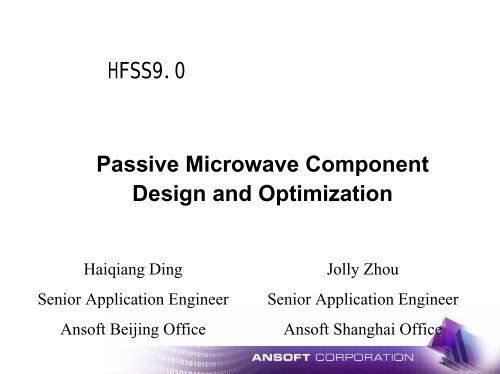
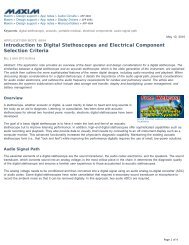
![P-CAD EDA - [Sheet1]](https://img.yumpu.com/49470492/1/190x115/p-cad-eda-sheet1.jpg?quality=85)
